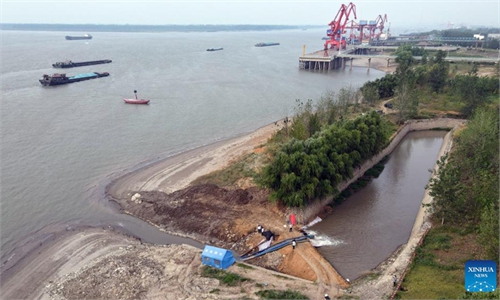China records highest number of hot days in six decades
Scorching weather increases demand for sun protection items, as well as electricity

A boy cools himself at a fountain in Beijing, June 23, 2023. Beijing issued a red alert for high temperatures on Friday, the highest in China's alert system, as a scorching heatwave hit the city. The weather forecast predicts a "prolonged battle" against high temperatures in the following week. (Photo: China News Service/Jia Tianyong)
"I've lived in Beijing for three decades, but I've never experienced a summer as hot as this one," complained a 53-year-old Beijing resident surnamed Su on Sunday. His complaint was supported by China's National Climate Center (NCC), which announced on Sunday that the country has recorded the highest number of hot days in the past six decades, and that the occurrence of multiple heat waves engulfing the country's northern cities is extremely rare.
According to a notice by the NCC, China has recorded an average of 4.1 days this year where the temperature exceeded 35 C, the highest number since records began in 1961. Within the northern region, capital Beijing has been the most severely affected, followed by the neighboring Hebei Province and Tianjin Municipality.
From June 21 to Friday, 22 weather observatory points in North China recorded historically high temperatures, and a total of 450,000 square kilometers of land experienced temperatures exceeding 37 C in recent days. Beijing recorded consecutive days of temperatures over 40 C in June, said the NCC.
"Going out in Beijing these days is like surfing in an oven," Su joked. To help outdoor workers cope with the heat, Beijing has set up "cooling booths" that provide cold water, air-conditioned areas, and sometimes free laundry services.
The NCC said that the scorching heat in North China is very rare. It predicted that the heat waves will keep engulfing some parts of North and Southwest China, with temperatures 1 C to 2 C higher than previous years.
"This round of heat is strong, long-lasting and widespread," said Zhao Wei, chief forecaster of the Beijing Meteorological Station. "The reason behind this is that the Beijing-Tianjin-Hebei region is under a warmer air mass from recent days and the influence will last for a while. Under the influence of a high-pressure ridge, the sky is clear with no cloud cover, which makes it easier for solar radiation to create heat," Zhao told the Global Times.
Hot weather has increased the demand for sun protection products, such as face bikini, ice silk sunscreen sleeves and masks, among consumers. Data from China's e-commerce platforms suggest that people in Beijing, Guangdong and Jiangsu spent the most on sun protection items.
Moreover, sales of face bikini, masks and other items have increased 50 percent compared with the same period last year.
Meanwhile, the country's National Meteorological Center (NMC) on Sunday issued a blue alert for the southwestern region of China for the following days. Six people died in Wanzhou, Southwest China's Chongqing Municipality, on Friday due to a landslide caused by heavy rain.
This summer has witnessed an increase in unusual weather patterns across the globe. Heat waves, like the one that affected parts of the South and Midwest of the US and resulted in the deaths of more than a dozen people, are becoming more common, American experts say the extreme weather events, which claim more lives than hurricanes and tornadoes, are expected to increase in the future.
According to Zhou Bing, chief of climate service of the China Meteorological Administration (CMA), China has recently experienced a high frequency of extreme weather associated with the emergence of the El Nino phenomenon.
"The development of El Nino will lead to an increase in rainfall in southern China in summer and a decrease in rainfall in northern China, with flooding in the south and drought in the north," said Zhou.
Due to persistent heat waves, China's power grids faced challenges last summer. The China Electricity Council said that this year, the maximum load on the grid will reach 1.37 billion kilowatts, which is 80 million more than last year. The council also predicted there will be a balance between supply and demand of electricity in China this summer, media reported on Sunday.
In order to cope with the surging demand for electricity, State Grid has put several power grid projects into operation in recent days.
For example, a power grid project in Southwest China's Sichuan was put into use on Friday, bringing the total number of completed projects aimed at handling peak summer demand to 15. These 15 projects will increase Sichuan's power supply capacity by 4.78 million kilowatts.



